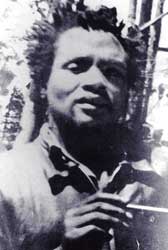Kenyans honor liberation hero Dedan Kimathi
By
Stephen Millies
Published Feb 18, 2007 3:49 PM
Field Marshal Dedan Kimathi was executed on Feb. 18, 1957, by the British
occupiers of Kenya. Being captured with a loaded revolver was enough to send
this freedom fighter to the gallows. Kimathi was hanged because he was a leader
of Kenya’s Land and Freedom Army, demonized by the media as the
“Mau Mau.”
According to David Anderson’s “Histories of the Hanged,”
1,090 Africans were hanged in the 1950s by Britain’s colonial regime in
Kenya. Just for supplying food to guerilla fighters—labeled
“consorting”—the colonialists sent 207 people to their
deaths.
In her Pulitzer Prize winning book “Imperial Reckoning,” Caroline
Elkins estimated that 300,000 Kenyans were thrown into concentration camps.
Elkins and her assistant Ms. Terry Wairimu, a researcher at the Kenyan National
Archives, interviewed 300 survivors. They heard how Alsatian dogs mauled women
inmates at the Athi River camp and guards clubbed prisoners arriving at the
Manyani camp.
Six hundred children were confined in Kamati camp alone. Almost none
survived.
“Hard Core Mau Mau” supporters were selected to bury the children.
“They would be tied in bundles of six babies,” recalled former
inmate Helen Macharia.
The people of Kenya considered British Prime Minister Winston Churchill as evil
a tyrant as the Nazi leader Adolf Hitler. Over a million Kikuyu people were
forced into 800 “emergency villages” built with their own slave
labor.
Queen Elizabeth II, who was already on the throne during these atrocities,
isn’t the only war criminal who should be put on trial. U.S.
“foreign aid” helped pay for the Embaksi Airport, which was
constructed with the bare hands of prisoners.
Stealing the land
In 1895, British Queen Victoria declared a “protectorate” over
Kenya and Uganda. A few British settlers stole the best land. One named Lord
Delamere grabbed 160,000 acres.
Troops wielding machine guns forced Africans into “native reserves”
that were modeled on U.S. Indian reservations. As in South Africa under
apartheid, Africans were forced to carry a pass, known in Kenya as a
“kipande.”
“We have stolen his land,” declared the British explorer and
land-grabber Colonel Grogan. “Now it is time to steal his limbs.”
The colonial regime enforced compulsory labor from African women and men. Ten
thousand workers, many from India, were killed or maimed building a 582-mile
long railroad from Mombasa to Lake Victoria.
“Illiterates with the right attitude to manual labor are preferable to
products of the schools” declared a 1949 report written by Anglican
Bishop Leonard Beecher. Three high schools at the time annually admitted 100
African students.
The average yearly wage of 385,000 African workers in 1948 was $73.
Freedom by any means necessary
Jomo Kenyatta became president of the Kenyan African Union in 1947. The same
year women in Murang’a revolted against being forced to build terraces
that often washed away in the rain.
The East African Trade Union Congress (EATUC) was founded on May Day in 1949.
The following May Day it demanded independence and majority rule.
Though Britain had a “Labor Party” government, its colonial regime
immediately arrested union leaders. One hundred thousand workers joined a
general strike. Nairobi was paralyzed for nine days. Nothing moved on
Mombasa’s docks for 48 hours.
Only a mobilization of the army and police broke the strike. EATUC President
Fred Kubai was jailed for eight months. General Secretary Makhan Singh, whose
origins were South Asian, was detained without trial for 11 years.
Their jailing symbolized the unity of Kenyan workers of both African and Asian
origin against colonialism.
Kenyan revolutionaries made preparations for armed struggle against the
oppressive colonial rule. Kenya’s colonial Governor Evelyn Baring
responded by declaring a state of emergency on Oct. 20, 1952. The
governor’s family controlled Barings Bank, founded in 1762 by the slave
trader Francis Baring.
Jomo Kenyatta, Fred Kubai and four other defendants were put on trial for
leading the Mau Mau. There was no jury. According to Elkins, the governor
guaranteed conviction by arranging a 20,000-pound bribe to the judge.
Baring hoped Kenyatta’s frame-up would demoralize Africans. It ignited
years of guerrilla warfare instead.
Mau Mau fighters stole weapons and ammunition. Blacksmiths made hundreds of
guns.
Britain mobilized 55,000 soldiers and cops to fight the Mau Mau. The Royal Air
Force bombed guerrilla strongholds in Aberdares Forest and Kirinyaga.
A posse led by Ian Henderson finally captured Field Marshal Kimathi on Oct. 21,
1956. A notorious torturer of Mau Mau suspects, Henderson’s cruelty
couldn’t stop the revolution. Twenty thousand Mau Mau guerrillas
didn’t die in vain. Kenya declared its independence on Dec. 12, 1963.
Africa remembers its heroes. Kimathi’s execution is commemorated and
streets are named in his honor. A statue of Dedan Kimathi was unveiled in
Nairobi on Dec. 11, 2006.
In October 2006, Mau Mau veterans filed a suit against the British government
for reparations, charging it with systematic torture of Kenyan freedom fighters
during the struggle for independence. The fallen and wounded “Mau
Mau” are being avenged in Iraq and wherever else people are fighting
against imperialist occupation for land and freedom.
Long live the memory of Field Marshal Dedan Kimathi! ν
Histories of the Hanged and Imperial Reckoning are available at
www.Leftbooks.com
Articles copyright 1995-2012 Workers World.
Verbatim copying and distribution of this entire article is permitted in any medium without royalty provided this notice is preserved.
Workers World, 55 W. 17 St., NY, NY 10011
Email:
[email protected]
Subscribe
[email protected]
Support independent news
DONATE


